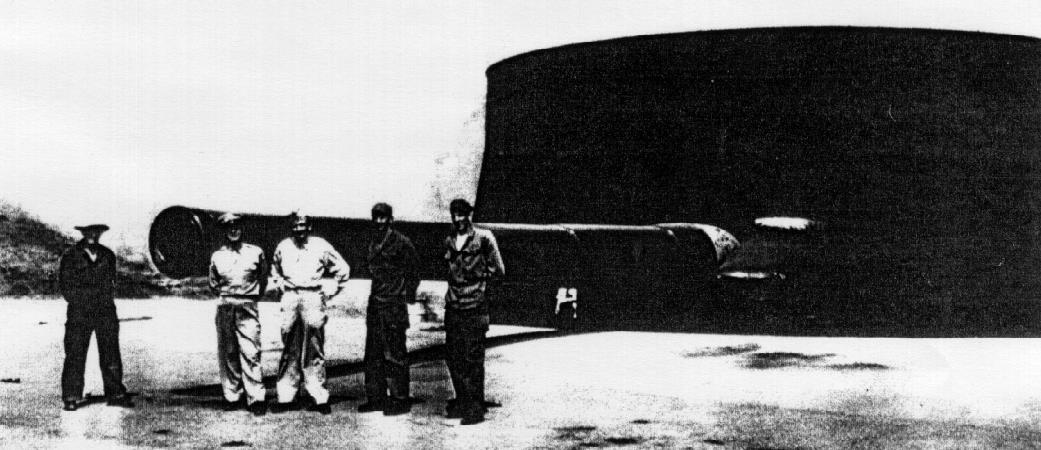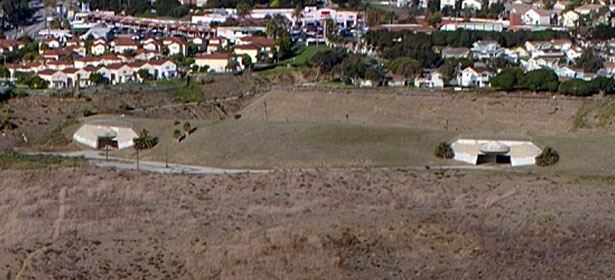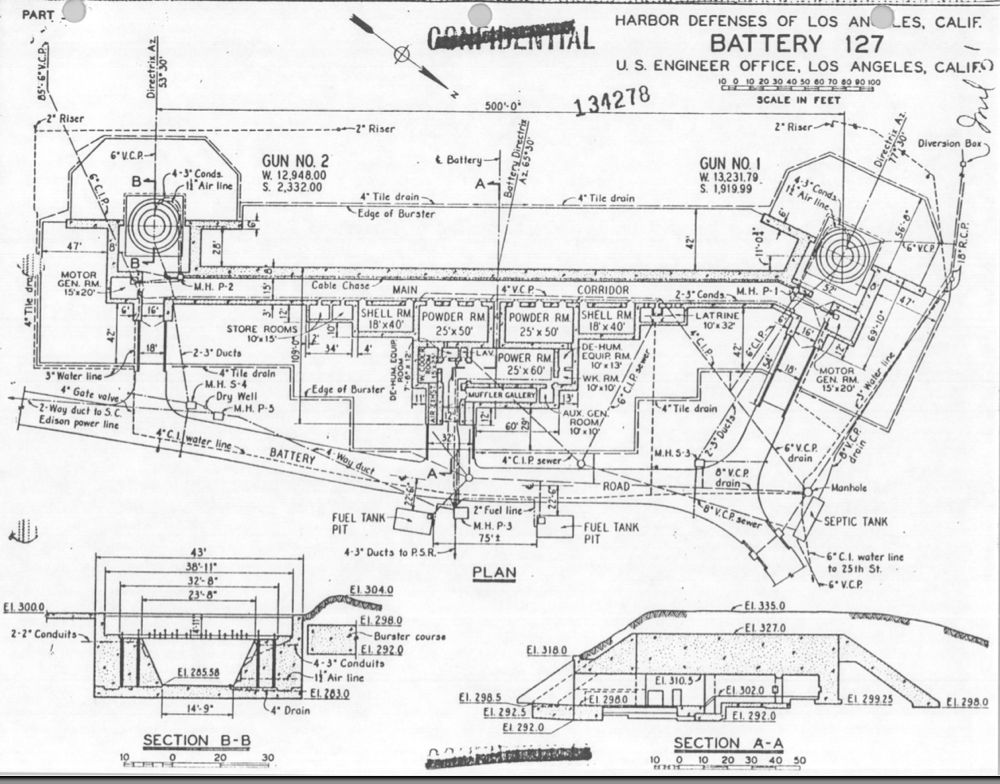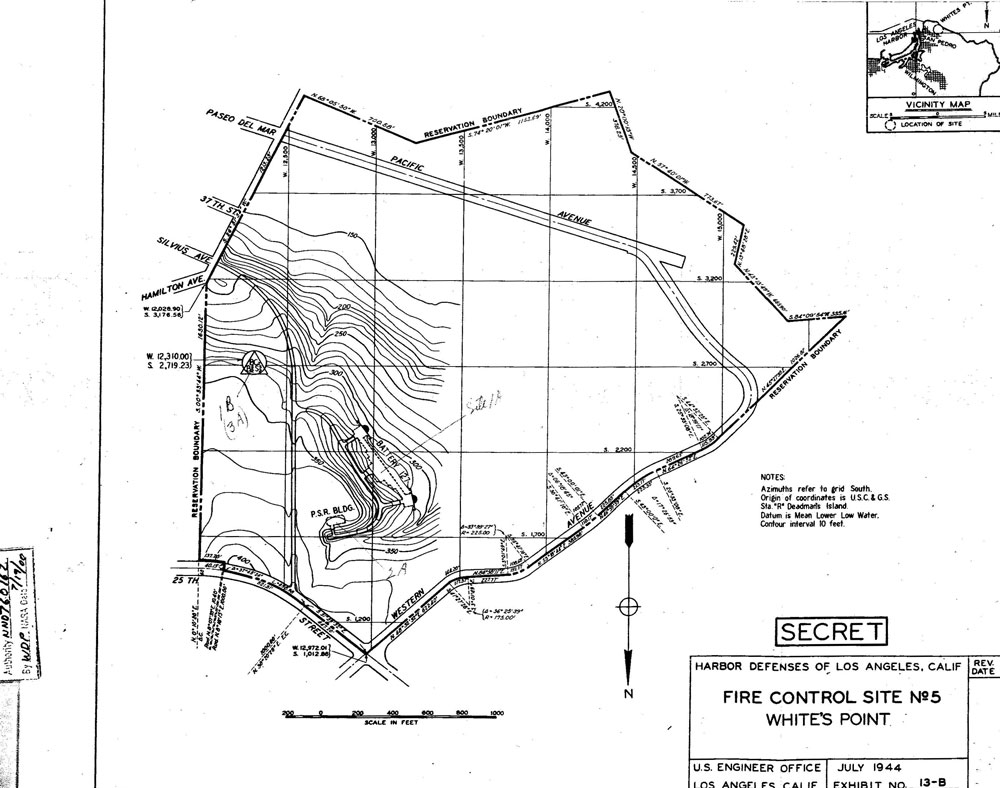

White Point was a very active military post for over a half century. In fact, planning for the construction of the White Point facilities began in 1917. However, the entire White Point Reservation would not be acquired until July 1942 despite litigation which dragged on to 1945.
Fort MacArthur's Fortress Commander's Station and the Fire Commander's Station were located on White Point. These two stations were completed in June 1920. These were the "bunkers" where the highest ranking officers would have "fought" from had an attack been directed at the Los Angeles Harbor. Additionally, White Point consisted of six fire control stations. These fire control stations were for Battery Osgood, Battery Farley, Battery Leary, Battery Merriam, Battery Barlow, and Battery Saxton, which were also completed in June 1920. Battery Paul D. Bunker was constructed during the years 1942-1944.
Directly after World War II, several of these fire control stations were used to support very early radar for the so-called "Lashup System" that later evolved into the SAGE system. By a strange circumstance the radar site was designated LA43, just as the later Nike site was designated 43L.
Battery Paul D. Bunker was a single gun battery with two guns. The term for the individual gun aperture in a wall or parapet is embrasure. These guns were subsequently scrapped in 1948 and the area was used as a target range. White Point also had an airstrip that ran parallel to Paseo del Mar, a flame-thrower range, a hand grenade range, a skeet range, an area for training tank drivers, and an area used to train engineers to put up Bailey bridges.
In 1954, White Point became a Nike missile battery. The Nike program was a missile antiaircraft defense system intended to protect cities from air attack during the early days of the Cold War. The Launcher (LA-43L) and Administrative (LA-43A) areas were located at White Point whil the Integrated Fire Control (LA-43C) area was located atop the former Batteries Leary and Merriam at Fort MacArthur's Upper Reservation. As a Nike-Ajax missile site, new construction of underground magazines, a generator room, a ready room and sentry posts began. These were completed in 1957 and manned by the 3rd Battallion of the 57th Artillery until 1962. By the mid-1960s the Nike system had become obsolete. The site was upgraded for the Hercules missile. During the years of 1963-65, administrative buildings, missile assembly and test buildings were built on the site. The site remained in a state of combat readiness until 1975. Three years later, in 1978, the U.S. Secretary of the Interior transferred the White Point property to the City of Los Angeles for public park and recreation purposes.
Just prior to World War II and during the early 1940s five new large caliber batteries were authorized for construction for the Harbor Defenses of Los Angeles. Part of the armament designated for Fort MacArthur in 1940 was two 16-inch batteries much like San Diego with one battery on a high ridge and the second at sea level.
The first of these to be constructed was Battery 127. The construction was located at White Point Military Reservation, which was originally acquired in 1910 for base-end stations. The reserve was enlarged in 1940 for the construction of Battery Construction 127. These 16-inch batteries were the largest, most technically complex and most expensive of any of the Army large gun facilities.
Construction began on the casemated concrete structure on April 13, 1942. The burster course was integrated into the casemated structure. The battery was completed in December 1943 and transferred to the Coast Artillery in September 1944 at a cost of $1,256, 409. The battery was located 306 feet above sea level against the Palos Verdes Hills. Its guns were 16-inch, 66.7 feet long Model Mark II M1, Nos. 54 and 72 made by the Watervliet Arsenal. They were mounted in July 1944 on high angle barbette carriages Model M-4, Nos. 30 and 45, constructed by the Wellman Engineering Company and Mesta respectively. The two great guns could lob a shell weighing 2,340 pounds at a target 26 miles distance.
The right No. 1 gun was canted to the west by 22 degrees and 30 minutes to better cover those approaches to the San Pedro Harbor.
A second building was constructed a few hundred feet behind and above the main battery at 329 feet above sea level. This was the casemated plotting, spotting, switchboard and radio building or P.S.R. It was transferred in September 1944 and cost $132,189. It used an M-1 data computer, an M-4 plotting board and an M-5 transmission unit.
In January 1945, this battery was named in honor of Paul D. Bunker. The origin of this designation has not been discovered. In May 1948, Battery Bunker was disarmed.
In the 1950s, the White Point Military Reservation was used as a Nike launch site for LA-43L. This missile battery was closed down in the late 1960s.
In 1993, the Reservation was leased to the City of Los Angeles for possible use as a park. The Fort Commander's fire control station and the primary Fire Command Station were destroyed during the construction of Navy housing there in 1965. The other seven stations at this Reservation have been partially buried but are still visible on the ridge to the east of Battery Bunker. The great casemate for Battery Bunker can still be seen from the road against the hills behind it. Right along the road can be seen the concrete Nike missile storage vaults in 1997.
Battery Bunker and the Nike launch site have been fenced to prevent vandalism. However, there are holes in the fence so the author could tour and photograph both sites in 1997.
The second 16-inch battery was Battery Construction No. 128 constructed at the Bolsa Chica Military Reservation to the east of San Pedro Harbor. Again a casemated Battery for two 16-inch guns and a P.S.R. fire control building were constructed as at Battery Bunker. However these were located only 50 feet above sea level. Construction began in April 1943. The two concrete casemated buildings were completed by January 1944 when all work on large battery programs was curtailed and finally suspended in January 1945. The two guns and carriages were never shipped. At the time the project was curtailed, $758,878 had been spent on construction. The abandoned buildings were filled with dirt in the 1950s. The entry way to Battery 128's P.S.R. building is visible from a riding stable at the rear of the old reserve but it is sealed shut. In 1993, a developer had planned to demolish the remains of this battery and replace it with condominiums.
References: The last large gun program is described in America's Last Seacoast Defenses: The World War II-Era Construction Program by Mark Berhow, Coast Defense Study Group Journal Vol. 8, No. 3, August 1994, pgs. 32-48; and Service of the Piece 16-inch Gun, Casemated FM 4-86, War Department, 10 August 1944.
Units Assigned to Los Angeles Defense Area Site LA-43
|
|
|
|
| Wings of Supersonic Steel | November 1954 - September 1958 |
|
| Wings of Supersonic Steel | 1956 - September 1958 |
|
| Wings of Supersonic Steel | September 1958 - June 1963 |
|
| Wings of Supersonic Steel | June 1963 - March 1974 |
|

Report of Completed Works - Seacoast Fortifications


